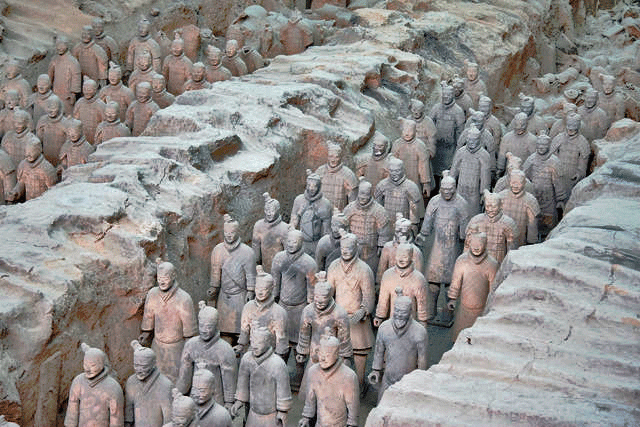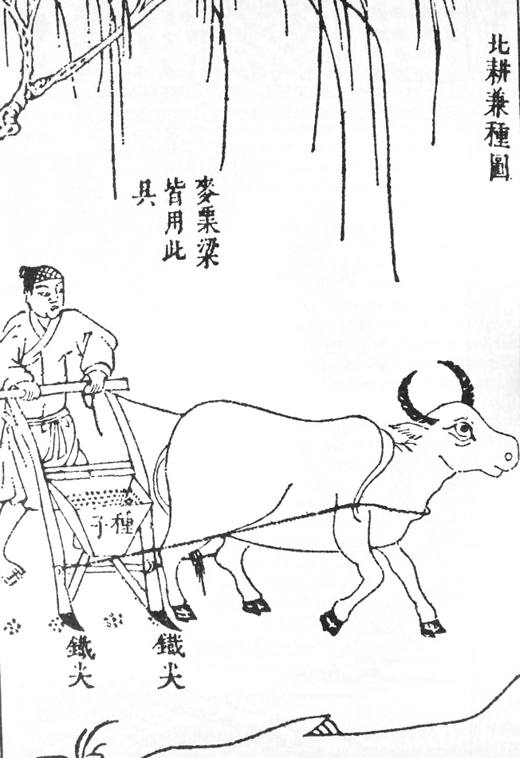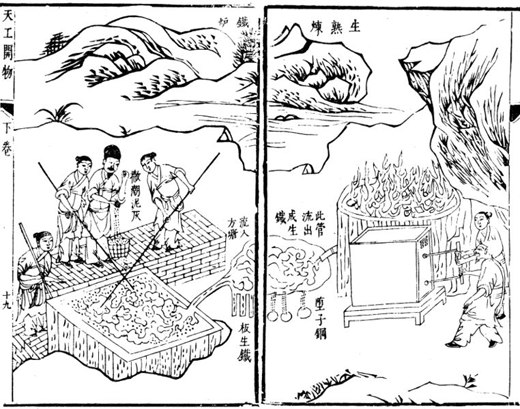
Part of Qin Shi Huang's terracotta army

Part of Qin Shi Huang's terracotta army
In 221 B.C. the Qin kingdom conquered its last rival and the Qin ruler became the first Chinese emperor. Among Qin Shi Huang's lasting achievements was the consolidation of various earlier defensive walls into the Great Wall of China. He is also known for the thousands of life-sized statues—the terracotta army—that were buried with him. Qin Shi Huang's darker side included stamping out dissent by banning books and executing scholars. Qin Shi Huang's rule lasted only 12 years, but it crystallized an economic and political system that lasted 21 centuries.
The imperial system divided Chinese society into five broad classes: the nobility and the "four occupations." In order of decreasing status, the "four occupations" included the shi (gentry), nong (farmers), gong (craftspeople), and shang (merchants). Three of the classes were viewed as central to society: the nobles who ruled the country, the gentry who ran it, and the farmers who made it all possible.

A farmer uses a seed drill to plant his crop.
From a Chinese encyclopedia published in
1637.
The base of China's economy was millions of farmers, who provided the food, cotton, silk, and other goods that China consumed. Much of the food they produced went to others: landlords, local nobles, or the empire itself. Grain tributes were especially important: the imperial government was fueled by northern wheat and southern rice. Through levies, farming communities also provided goods needed by the government—anything from bricks to tea. When that was not enough, farmers were conscripted for public projects. The best-known imperial project, the Great Wall, was famous as a place where conscripts were worked to death.
If wealth began at the bottom and flowed up, it was because power started at the top and flowed down. The emperor himself claimed to rule by the mandate of heaven, and in theory his power was absolute. The empire covered a huge area and included millions of people, so direct rule was impossible. Instead each emperor relied on a system of civil servants to carry out his will. The civil servants were supplied by the gentry, whose males had functioned as knights in pre-imperial times. The critical attribute of this class was its literacy, since government ran on paperwork. Shi men were further expected to master literary classics that spelled out the moral and practical basis of Chinese society. Like the nobles, the gentry did not perform manual labor, but they could pursue scholarly occupations such as painting and poetry.
The imperial system was born of military conquest, and imperial rule was maintained through harsh laws and punishments. Crimes could lead to the execution of the criminal's entire family, for example. In time, this harshness was tempered by the Confucian principle that while people should obey their rulers, the rulers should work to benefit their people. The same Confucian ideal applied to families. Male heads of households should govern wisely, other members of the household should obey, and the expected result was a mutually beneficial harmony.
As part of the same social ideal, women were subordinated to men. Only one women became Empress of China (Wu Zetian, 690–705). Elite women joined in power struggles but were forced to work behind the scenes, or at most acted as regents for underage emperors. Farmers' wives were supposed to stay at home and weave but given the realities of farm life, they often helped with the work in the fields.
As one consequence of unequal gender roles, powerful men had concubines in addition to their wives. Emperors often had hundreds of concubines, and the empress Wu Zetian began as the concubine of two successive emperors. To ensure that the imperial concubines' children were the emperor's, the concubines were served by eunuchs—who developed a powerful bureaucracy of their own. Zheng He, who commanded seven naval expeditions to the Indian Ocean, was a Ming dynasty court eunuch.
China's nobles required palaces; the gentry required elegant homes. Both required fine furnishings and servants. For clothing, only silk would do. The elite demand for fine things fostered a population of craftspeople, whose creations continue to amaze us today. Despite their talents, craftspeople were not viewed as central to society and as a class, they ranked lower than farmers.
China's elites viewed merchants as non-essential. While some merchants became rich, they were all viewed as having the lowest status of the "four occupations."
Concerns with power, status, and achievement was irrelevant to the vast majority of Chinese who lived by farming. Those men, women, and children all worked to survive. A folk song from difficult times laments, "This year famine, next year flood. Grass roots, tree bark gone for food."
For more than 2,000 years, Chinese society was much as described above. However, social life was not static. The most obvious source of change was the inherent instability of imperial rule: so much power attracted the power-hungry. Dynastic continuity masked palace power struggles that often cost emperors their lives. Twice the old dynasty was swept away during internal struggles, allowing the victors to establish a new regime. The Han did this in 206 BCE, and the Tang in 618.
Twice the empire fell apart, to be replaced by smaller, competing kingdoms. This was the case from 222 to 589 (the Six Dynasties period) and again from 907 to 960 (the Five Dynasties and Ten Kingdoms period). During the turmoil, the competing kingdoms maintained imperial approaches to government and the Chinese social fabric never unraveled. At the end of each period, one kingdom was victorious and re-established a unified empire. The Sui Dynasty began this way in 589, and the Song in 960.
Twice, warriors from the north swept past the Great wall and established themselves on the imperial throne. In 1279 Kublai Khan, grandson of Genghis, founded the Yuan dynasty. Mongolian emperors ruled until 1368, when the Yuan dynasty was deposed by armies led by a peasant-born Buddhist monk—who then founded the Ming dynasty. In 1644 the Ming were overthrown by a new wave of northern invaders, this time from Manchuria. The invaders established the Qing dynasty, which ruled China until the end of the imperial era.
Challenges to imperial rule sometimes came from below. When the central government weakened, local nobles could increase their own power. When order and prosperity slipped, banditry and piracy flourished. At times, farmers' lives became so desperate that they risked the little they had and rose against their rulers. While the imperial system survived these challenges again and again, Chinese history includes a long list of internal wars.
Religion was also a source of social tension. Taoism and then Buddhism provided alternatives to Confucianism. When the Chinese extended their empire westward, they absorbed Muslim populations. Other religions, including Christianity, gained Chinese converts.
Many changes were more positive. Paper was invented in China and spread from there to the Muslim world and then to Europe. The Chinese also invented porcelain, a feat the West was unable to duplicate for centuries. The Chinese advanced the making of steel, including by inventing the blast furnace. Two other Chinese inventions, the compass and gunpowder, became critical to European expansion.

Smelting iron ore. The blast furnace is on the right. From a Chinese
encyclopedia published in 1637.
A national system of canals and roads, with official way stations and couriers, made it easer to move grain and other tributes, armies, imperial officials, and state documents around the country. The unintended beneficiaries of the transportation system were the merchants, who could reach more distant markets. Local markets increasingly became nodes in larger systems of commerce.
The merchants also benefited from the development of a monetary system. Coinage began before the imperial era, but was now standardized. Chinese imperial coins had holes that allowed them to be strung on cords. By the Tang dynasty, merchants began circulating paper receipts to avoid transporting the heavy loops of coins, and in the Song dynasty such receipts were transformed into the world's first government-backed paper money. Merchants created their own medium of exchange: small ingots of silver and gold. Known as sycees, the ingots continued in use until the early 1900s. In the Ming dynasty the government both recognized and intensified the emergence of a money-based economy by taking taxes in the form of silver rather than grain and other goods.
As part of the country's economic growth, merchants also established international trade routes, by land (via the Silk Road) and by sea. By the final centuries of the empire the merchant class had become highly successful. Unlike countries in the West, the central government never worked its merchants into its system of governance, and thus never co-opted their connections and abilities. By the Ming dynasty, however, local officials often were more pragmatic about the supposedly lowly merchants. Faced with the need to maintain public projects, the officials turned to the merchants for donations. In turn, the merchants cultivated the local officials, gaining prestige and smoothing the way for their own activities. In hindsight, China's mercantile class was essential to the empire's economic health, contradicting the merchants' supposed low social status.
The empire had little control over the greatest change it faced: the rise of a global economy dominated by Western nations. For much of the empire's history the Chinese had rightly regarded themselves as the world's most successful civilization, but from the 1500s onward China was in a game increasingly controlled by others. In a sense, the imperial system had worked too well; the Westerners' drive to innovate and conquest was fueled by a wish for wealth and splendor, but China's leaders had those already, and had nothing to gain personally by changing the country. Outside countries pried open China to benefit their commerce, mostly through a series of humiliating military campaigns. Outside ideas came in as well, presenting alternatives to imperial rule. In 1911 a revolution overthrew the Qing dynasty, ending the empire established in 221 B.C.
See source code for copyright information.
Page last revised on December 10, 2014.
Please report problems to dap@unm.edu